sour cream bread
 Beard On Bread, at least my copy, is a slim little mass-market paperback compilation of great bread recipes from the legendary James Beard. The man knew what he was doing. The book starts with information about flours, equipment and techniques, but moves quickly to bread recipes. Offerings range from basic white breads to dark and rye breads, dessert and sweet breads,
Beard On Bread, at least my copy, is a slim little mass-market paperback compilation of great bread recipes from the legendary James Beard. The man knew what he was doing. The book starts with information about flours, equipment and techniques, but moves quickly to bread recipes. Offerings range from basic white breads to dark and rye breads, dessert and sweet breads,  quick-rise rolls, flat breads and even fried dough offerings.
quick-rise rolls, flat breads and even fried dough offerings.
I had to check the volume carefully to make sure I didn’t try anything I’ve done before. That ruled out at least one oatmeal bread, some biscuit recipes and the cinnamon bread, which is designed as a cinnamon-flavored loaf but which I like to use as a base for a substantial cinnamon 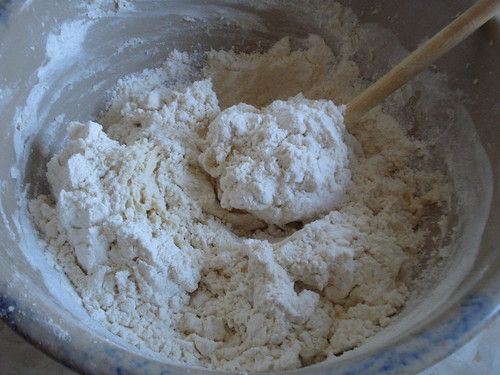 roll, thickly layered with nuts and cinnamon sugar and slathered with cream cheese frosting. (That particular recipe is fun for a weekend breakfast, and you can save time by making it the night before, shaping the rolls and then putting the pans in the fridge overnight for a slow rise — just let them sit at room temperature for about half an hour before they go into the oven.)
roll, thickly layered with nuts and cinnamon sugar and slathered with cream cheese frosting. (That particular recipe is fun for a weekend breakfast, and you can save time by making it the night before, shaping the rolls and then putting the pans in the fridge overnight for a slow rise — just let them sit at room temperature for about half an hour before they go into the oven.)
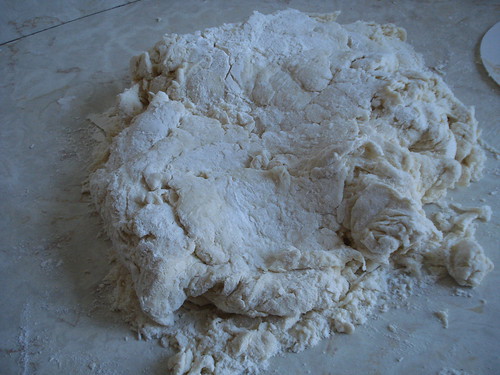 I chose sour cream bread, because I don’t care for rye bread and I wanted something that could go with dinner rather than a sweet breakfast bread. Sour cream bread is also a good choice because it’s fairly easy and takes only two rises.
I chose sour cream bread, because I don’t care for rye bread and I wanted something that could go with dinner rather than a sweet breakfast bread. Sour cream bread is also a good choice because it’s fairly easy and takes only two rises.
I started by proofing some yeast with sugar and water. While the mixture began to bubble, I mixed  sour cream with some salt and baking powder. Then I added the yeast mixture to the sour cream and stirred in four cups of flour. The recipe said the dough was supposed to be very wet and sticky at this point; mine was sticky but not especially wet, so it was not difficult to turn out onto a floured counter and knead into a springy but not-too-sticky ball. I washed and buttered the mixing
sour cream with some salt and baking powder. Then I added the yeast mixture to the sour cream and stirred in four cups of flour. The recipe said the dough was supposed to be very wet and sticky at this point; mine was sticky but not especially wet, so it was not difficult to turn out onto a floured counter and knead into a springy but not-too-sticky ball. I washed and buttered the mixing 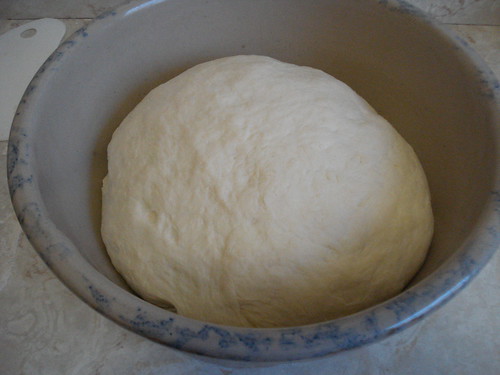 bowl, thumped the dough into it and turned it over so the top side was buttered, covered it with plastic wrap, and let it rise. The recipe says to let it rise “until doubled,” without specifying a time; our kitchen was a bit cool, so when I checked it at 75 minutes I didn’t think it had doubled. The two-hour mark showed better results.
bowl, thumped the dough into it and turned it over so the top side was buttered, covered it with plastic wrap, and let it rise. The recipe says to let it rise “until doubled,” without specifying a time; our kitchen was a bit cool, so when I checked it at 75 minutes I didn’t think it had doubled. The two-hour mark showed better results.
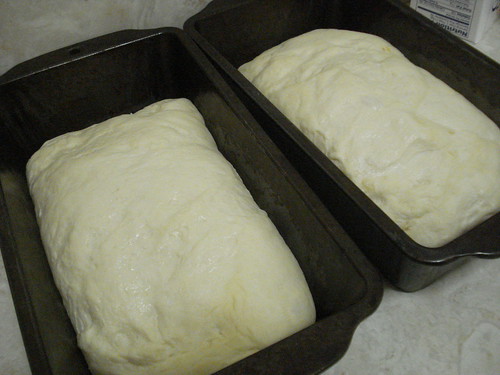 Now I buttered two loaf pans, then turned out and punched down my dough, kneaded it briefly, and shaped it into loaves. I don’t remember where I learned this particular trick, but for a nicely shaped loaf, I shape the dough into a rectangle approximately the size of my pan, press it into the loaf pan so that it’s fully stretched to all sides, and then lift it out and turn it over.
Now I buttered two loaf pans, then turned out and punched down my dough, kneaded it briefly, and shaped it into loaves. I don’t remember where I learned this particular trick, but for a nicely shaped loaf, I shape the dough into a rectangle approximately the size of my pan, press it into the loaf pan so that it’s fully stretched to all sides, and then lift it out and turn it over. 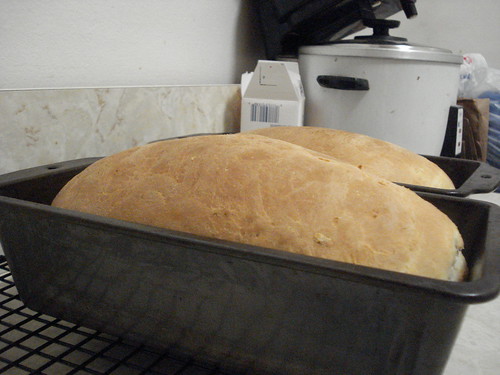 This ensures that the top is buttered and reasonably level for the second rise. I loosely covered the pans and let them rise for a little more than an hour.
This ensures that the top is buttered and reasonably level for the second rise. I loosely covered the pans and let them rise for a little more than an hour.
When the timer went off I preheated the oven to 375, and put in the loaves for 35 minutes. At the end of the baking they were nicely browned and made a good sound when thumped. I let 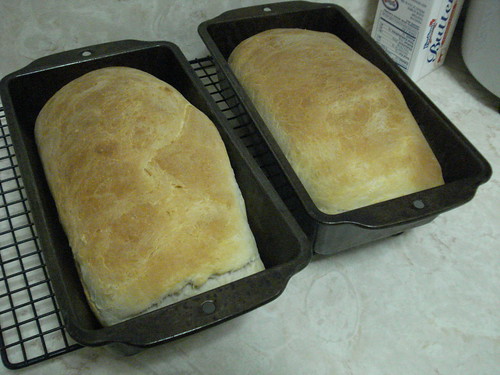 them cool in the pans for about five minutes, then turned the loaves out onto the rack and let them cool a bit longer. I was in luck: The dinner I was making required a higher baking temperature, so I had to bake the bread ahead of time. This gave the loaves enough time to cool so that I could slice them neatly, instead of hacking them into primitive chunks as I’m prone to
them cool in the pans for about five minutes, then turned the loaves out onto the rack and let them cool a bit longer. I was in luck: The dinner I was making required a higher baking temperature, so I had to bake the bread ahead of time. This gave the loaves enough time to cool so that I could slice them neatly, instead of hacking them into primitive chunks as I’m prone to 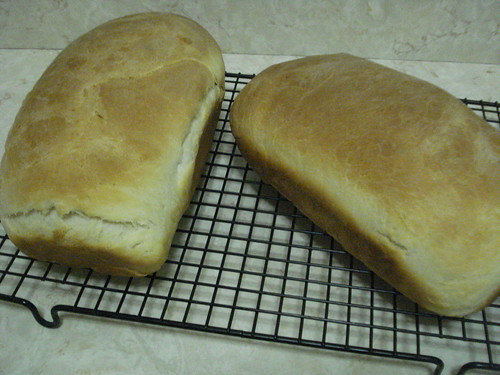 do with fresh hot bread.
do with fresh hot bread.
The bread was delicious, with a smooth, light texture and a subtle tang. It’s going to be great for toast, I can see.
Verdict: Success. Easy, delicious, well worth the (minimal) effort.